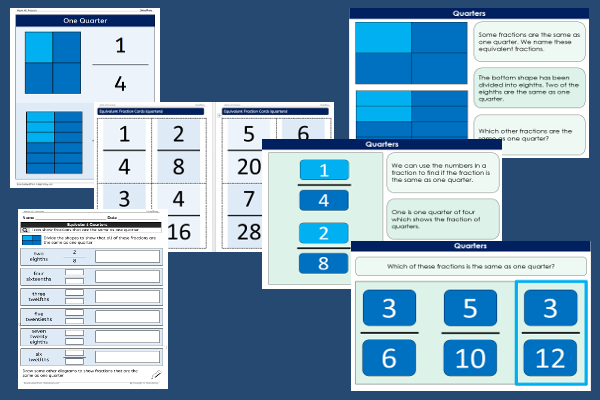Home > Key Stage Two > Maths > Number > Fractions > Equivalent
Equivalent Quarters

This maths teaching pack for Key Stage Two gets the children to identify and record equivalent fractions to match different numbers of quarters using diagrams and number calculations for multiplication and division.
The class can show how different non-unit fractions can match other fractions with an equivalent value for their numerators and denominators.
Download this teaching pack including display posters, classroom activities and an interactive presentation to identify and record equivalent fractions to match different numbers of quarters using diagrams and number calculations for multiplication and division
Activities in this teaching pack include display posters to identify equivalent fractions to match different numbers of quarters shown using diagrams and non-unit fractions, cards to match different numbers of quarters recorded using non-unit fractions and worksheets to model equivalent fractions to match different numbers of quarters by recording pairs of diagrams and calculations to show the values of each non-unit fraction
The interactive presentation gets the children to explore how to record and illustrate fractions that are equivalent to different numbers of quarters by using diagrams and number calculations.
This lesson can support development in exploring the equivalence between different sets of fractions. There are teaching activities for shared learning, differentiated worksheets to support independent learning and an interactive presentation to introduce concepts and key skills.
-

School Grounds
Explain and model how to measure and calculate the perimeters and areas of different shaped locations around the school grounds
-

Rainforest Presentations
Select, manipulate and combine different forms of media to create a multimedia presentation about an aspect of life in a rainforest habitat
-

Flag Printing
Practise and refine different techniques when printing colours, shapes and patterns to design flags to match specific locations
-

Angle Observations
Identify, locate and classify examples of right, acute and obtuse angles that can be observed in a range of different shapes, objects and locations
